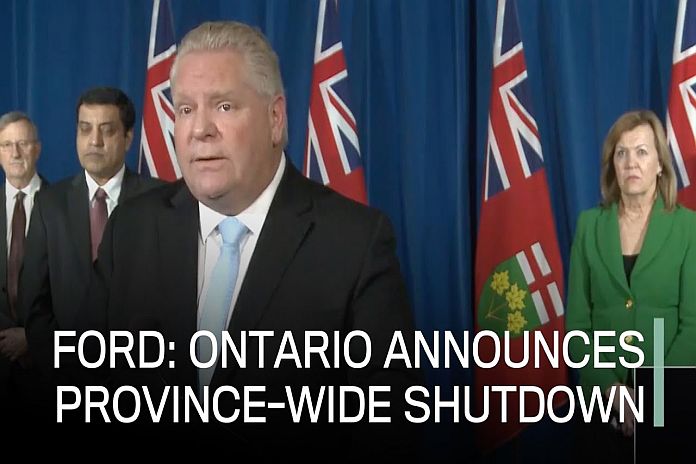TORONTO — As COVID-19 cases continue to rise at an alarming rate, the Ontario government, in consultation with the Chief Medical Officer of Health and other health experts, is imposing a Provincewide Shutdown. The Provincewide Shutdown will go into effect as of Saturday, December 26, 2020, at 12:01 a.m.
Details were provided today by premier Doug Ford, Christine Elliott, deputy premier and minister of health, Stephen Lecce, minister of education, Dr David Williams, chief medical officer of health, and Dr Naveed Mohammad, president and chief executive officer, William Osler Health System.
“The number of daily cases continue to rise putting our hospitals and long-term care homes at risk,” said Premier Ford. “We need to stop the spread of this deadly virus. That’s why, on the advice of Dr Williams and other health experts, we are taking the difficult but necessary decision to shutdown the province and ask people to stay home. Nothing is more important right now than the health and safety of all Ontarians.”
In response to these exceptional circumstances, the Provincewide Shutdown would put in place time-limited public health and workplace safety measures similar to those in other jurisdictions. It would help stop the trend of high COVID-19 transmission in communities, preserve health system capacity, safeguard vulnerable populations and those who care for them, and save lives. Measures include, but are not limited to:
- Restricting indoor organized public events and social gatherings, except with members of the same household (the people you live with). Individuals who live alone may consider having exclusive close contact with one other household.
- Prohibiting in-person shopping in most retail settings – curbside pickup and delivery can continue. Discount and big box retailers selling groceries will be limited to 25 percent capacity for in-store shopping. Supermarkets, grocery stores and similar stores that primarily sell food, as well as pharmacies, will continue to operate at 50 percent capacity for in-store shopping.
- Restricting indoor access to shopping malls – patrons may only go to a designated indoor pickup area (by appointment only), essential retail stores that are permitted to be open (e.g. pharmacy, grocery store), or, subject to physical distancing and face-covering requirements, to the food court for takeout purchases. Shopping malls may also establish outdoor designated pickup areas.
- Prohibiting indoor and outdoor dining. Restaurants, bars and other food or drink establishments will be permitted to operate by take-out, drive-through, and delivery only.
On the advice of the chief medical officer of health, all Ontarians are advised to stay home as much as possible with trips outside the home limited to necessities such as food, medication, medical appointments, or supporting vulnerable community members. Employers in all industries should make every effort to allow employees to work from home.
The current COVID-19 Response Framework will be paused when the Provincewide Shutdown comes into effect. The impacts of these time-limited measures will be evaluated throughout the 14 days in Northern Ontario and 28 days in Southern Ontario to determine if it is safe to lift any restrictions or if they need to be extended.The chief medical officer of health will assess and apply lessons learned thus far to the COVID-19 Response Framework to ensure appropriate and effective measures are in place to protect the health of Ontarians and enable economic recovery after the Provincewide Shutdown ends. This will include an assessment of how a revised approach for the safe reopening of retail may be operationalized, according to the latest available evidence.
“This was not an easy decision before the holidays, but we have reached a tipping point,” said minister Elliott. “We continue to see sharp increases in hospitalizations and occupancy in intensive care units is reaching concerning levels. Urgent action must be taken to prevent our health care system from becoming overwhelmed. By implementing a Provincewide Shutdown, we can work to stop the virus in its tracks, safeguard hospital capacity, and save lives.”
The government is also providing $12.5 million to implement a High Priority Communities Strategy to contain the virus in high-risk communities. The strategy will take a tailored, community-based approach to fund community agencies in 15 priority communities in the York, Peel, Durham, Ottawa, and Toronto regions. The funding will also allow for the hiring of community ambassadors to make people aware of available services and assistance, for coordination of increased testing opportunities and for the arrangement of wraparound supports for those who are COVID-positive. Additional funding of $42 million will also be available to establish isolation centres.
The province will work with our local municipal partners to establish new isolation centres to help those who may need to isolate following testing.
“We continue to see the number of cases in the province grow and the trends in public health indicators worsen. Additional measures are needed provincewide in order to interrupt this concerning growth,” said Dr Williams. “We must work together to enable everyone to follow these new and time-limited restrictions and protect our health system and our communities.”
The government is working to limit the transmission of COVID-19 in workplaces by supporting essential businesses in doing whatever is necessary to keep workers safe. The ministry of labour, training and skills development is leading a multi-ministry COVID-19 Safety Team. The team will partner with local authorities to carry out additional enforcement blitzes in sectors where they are needed most.
Uploaded by: Ottawa Citizen, 21 Dec 2020.





